Arisaema triphyllum
A distinctive looking flower makes this plant easy to identify once spotted
Arisaema triphyllum Jack-in-the-pulpit
This is not an easy native wildflower to spot as its colors often blend in with the background so well. Jack-in-the-pulpit is a perennial, herbaceous, woodland plant of the family araceae that blooms from April to June in damp woods and swamps of the eastern 2/3 of North America and in all Pennsylvania counties. It may grow up to 2 feet high, though it is generally a lot smaller. The plant sprouts each spring from an underground corm.
The unusual flower is the most interesting feature of this species. There is a leafy spathe (the pulpit) with a curved hood over the top, and an internal spadix (Jack, the preacher), which is covered with tiny male and female flowers. Younger plants produce more male flowers; more female flowers are produced in each successive season as the plant ages. When both male and female flowers are present, the male flowers are on the upper part of the spadix. The spathe is light green with strong ribs and sometimes, but not always streaked or spotted with purple. Flowers occur on a separate stalk about the same height as the leaves, the formation grows beneath large leaves. Leaves emerge after flowers.
The flowers emit heat and a mild foul odor that attracts flies and beetles as pollinators. The male flowers die before the female flowers mature so there is little or no self-pollination. There is no evidence that the flower captures and digests insects even though it resembles the carnivorous pitcher plants. It takes three or more years for a seedling to mature enough to produce a "pulpit." The resulting fruit is a shiny, cluster of berries born on the spadix. These appear in late summer and fall, turning from green to red as they ripen. Each berry contains 1-5 seeds.
The plant has a pair of dull green leaves with long stalks and each is divided into 3 parts. This shape sometimes causes people to think it is poison ivy.
The plant is inedible raw because of the chemical calcium oxalate that has a peppery taste and can produce a burning sensation in the mouth or digestive system even in small amounts. Native Americans are said to have eaten the underground corms and savored the strong spicy taste. Cooking eliminates this unpleasant property. Because of its rarity and unique flower form, using it as a wild food is not recommended. It is also called the bog onion, brown dragon or Indian turnip.
Jack-in-the-pulpit is a highly variable species, causing taxonomists to debate whether there are one or three species. The most recent study indicates that there are three reproductively isolated subspecies that are hard to distinguish visually. The most common of these has 56 chromosomes (a tetraploid) instead of the 28 chromosomes found in the other two. The tetraploid plants are possibly a fertile hybrid between the two diploids. The tetraploid subspecies is currently called Arisaema tripyllum triphyllum. Some botanists argue that if they are reproductively isolated, they should be considered 3 separate species. The formation of new plant species by the process of polyploidy is not uncommon.
Habitat & Range
Grows at edges of wetlands, in swamps/bogs, floodplains, and forests as well.
Present throughout the state.
| EMP: | FACW |
|---|---|
| NCNE: | FAC |
Phenology
Flowers March to June.
Fruits form in late summer.
Characteristics
Flower cylindrical and hooded, green with brown stripes.
Leaves compound, occuring in 1(male or non-flowering) or 2 (female) sets, each leaf with 3 leaflets. The middle leaflet is usually larger than the lateral two.
Fruit cluster of green berries that turn bright red in late summer.
Identification Tips
A. triphylla is not a carnivourous plant, although looks like one
Plant Codes
S-rank: S5 (Secure)
G-rank: G5 (Secure)

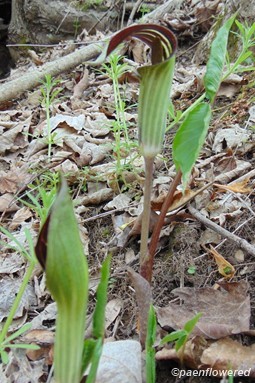


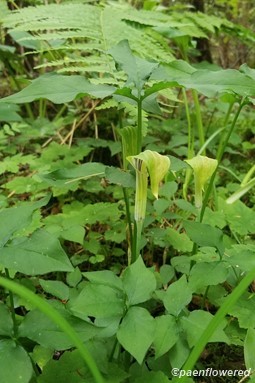
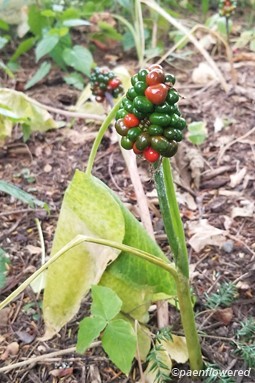
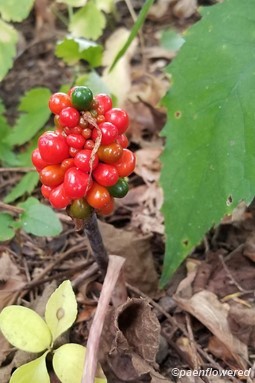

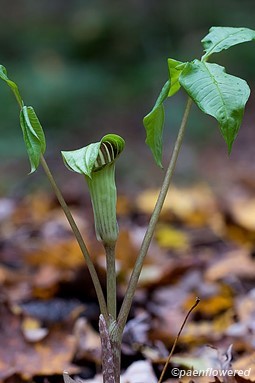


Comments
Have you spotted this plant in your area? We'd love to hear about your experience! Share your comments or questions about the plant below. Comments are moderated before posting.